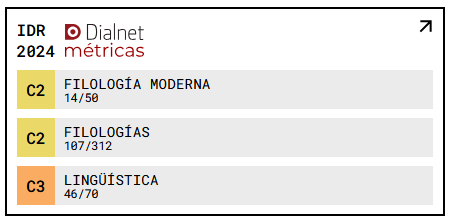Prayaag Akbar’s "Leila" and Margaret Atwood’s "The Handmaid’s Tale"
A Study on Dystopian Intersections
DOI:
https://doi.org/10.18172/jes.5548Keywords:
Dystopia, totalitarianism, regimentation, past, Atwood, AkbarAbstract
The turbulent historical period we are currently going through seems to have stimulated the production and publication of an overflowing number of dystopian narratives, which gravitate around a wide array of different topics. The publication of Margaret Atwood’s The Handmaid’s Tale, now turned into one of the most successful TV shows of the decade, has become a link between Zamyatin, Huxley and Orwell’s pioneering works and the latest publications in the field, among which Prayaag Akbar’s Leila stands as a most significant contribution. This paper, which is informed by the illuminating approaches of Atwood scholars and Indian dystopian theorists, will seek to trace a number of intersections between Atwood’s masterpiece and Akbar’s opera prima, focusing on the authors’ takes on some of the tropes that build up the dystopian atmosphere of these novels. Thus, this article will primarily delve into the constraining effects of regimentation, especially for the female protagonists of these works, and the manipulation of the past, as they are the source of profoundly illuminating common grounds.
Downloads
References
Akbar, P. 2018. Leila. New York: Simon and Schuster. Kindle.
Aldridge, A. 1984. The Scientific World View in Dystopia. Michigan: UMI Research Press.
Atwood, M. 1985. The Handmaid’s Tale. New York: Harcourt.
Atwood, M. 2011. “Margaret Atwood: the Road to Ustopia”. The Guardian, October 14, 2011. https://www.theguardian.com/books/2011/oct/14/margaret-atwood-road-to-ustopia. (Accessed 20 September 2021).
Atwood, M. 2013. “My Hero: George Orwell”. The Guardian, January 18, 2013. https://www.theguardian.com/books/2013/jan/18/my-hero-george-orwell-atwood. (Accessed 13 September 2021).
Banerjee, S. 2020. Indian Science Fiction: Patterns, History and Hibridity. Wales: University of Wales Press.
Barbé, S. 1990. “‘The World as It will Be?’ Female Satire and the Technology of Power in The Handmaid's Tale”. Modern Language Studies 11 (2): 39-49.
Cavalcanti, I. 2015. “The Writing of Utopia and the Feminist Critical Dystopia: Suzy McKee Charnas’s Holdfast Series.” Dark Horizons: Science Fiction and the Dystopian Imagination. Eds. Rafaella Baccolini and Tom Moylan. New York: Routledge. 47-68.
Cortiel, J. 2015. “Feminist Utopia/Dystopia: Joanna Russ, The Female Man (1975), Marge Piercy, Woman on the Edge of Time (1976)” Dystopia, Science Fiction, Post-Apocalypse: Classics, New Tendencies, Model Interpretations. Eds. Eckart Voigts-Virchow and Alessandra Boller. Trier: WVT. 155-169.
Cronan Rose, E. 1991. “The Good Mother: from Gaia to Gilead”. Frontiers: a Journal of Women Studies 12 (1): 77-97.
Dawson Varughese, E. 2017. Genre Fiction of New India: Post-Millennial Receptions of “Weird” Narratives. New York: Routledge.
Dawson Varughese, E. 2019. “Post-millennial ‘Mythology-Inspired Fiction’ in English: the Market, the Genre, and the (Global) Reader”. Indian Genre Fiction: Past and Future Histories. Eds. Bodhisattva Chattopadhyay et al. London and New York: Routledge. 141-158.
Dodson, D. 1997. “‘We lived in the blank white spaces’: Rewriting the Paradigm of Denial in Atwood’s The Handmaid's Tale”. Utopian Studies 8 (2): 66-86.
Falk, L. 1991. “Breaking Silences in Feminist Dystopias”. Utopian Studies 3: 7-11.
Hansot, E. 1994. “Selves, Survival, and Resistance in The Handmaid's Tale”. Utopian Studies 5 (2): 56-69.
Herrero, D. 2020. “Populism and Precarity in Contemporary Indian Dystopian Fiction: Nayantara Sahgal’s When the Moon Shines by Day and Prayaag Akbar’s Leila”. Atlantis 42 (2): 214-232.
Hickman, J. 2009. “When Science Fiction Writers Used Fictional Drugs: Rise and Fall of the Twentieth-Century Drug Dystopia”. Utopian Studies 20 (1): 141-170.
Indu, B. C. 2013. “Flowers of Survival: An Ecofeminist Reading of Margaret Atwood’s The Handmaid’s Tale”. International Journal of Humanities and Social Science Invention 2 (4): 7-9.
Krishnan, N. 2017. “Leila: A Mother's Quest for her Daughter”. The Wire, April 30, 2017. https://thewire.in/books/leila-prayaag-akbar-review. (Accessed 3 February 2022).
Kuhad, U. 2021. Science Fiction and Indian Women Writers: Exploring Radical Potentials. London and New York: Routledge.
Kumar, K. 1987. Utopia & Anti-Utopia in Modern Times. Oxford: Oxford University Press.
Moylan, T. 2000. Scraps of the Untainted Sky: Science Fiction, Utopia and Dystopia. Colorado: Westview.
Negley, G. and J. Patrick. 1952. The Quest for a Utopia: An Anthology of Imaginary Societies. New York: Henry Schuman.
Sengupta, D. 2019. “Explorers of Subversive Knowledge: the Science Fantasy of Leela Majumdar and Sukumar Ray”. Indian Genre Fiction: Past and Future Histories. Eds. Bodhisattva Chattopadhyay et al. London and New York: Routledge. 73-86.
Stillman, P. and S. Johnson. 1994. “Identity, Complicity, and Resistance in The Handmaid's Tale”. Utopian Studies 5 (2): 70-86.
Weiss, A. 2009. “Offred’s Complicity and the Dystopian Tradition in Margaret Atwood’s The Handmaid’s Tale”. Studies in Canadian Literature / Études en littérature Canadienne 34 (1): 120-141.
Downloads
Published
How to Cite
Issue
Section
License
Copyright (c) 2023 Juan F. Elices Agudo

This work is licensed under a Creative Commons Attribution 4.0 International License.
The authors retain copyright of articles and authorize Journal of English Studies the first publication. They are free to share, redistribute, and/or reprint the article without obtaining permission from the publisher as long as they give appropriate credit to the editor and the journal.
Self-archiving is allowed too. In fact, it is recommendable to deposit a PDF version of the paper in academic and/or institutional repositories.
It is recommended to include the DOI number.
This journal is licensed under a Creative Commons Attribution 4.0 International License













